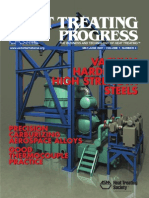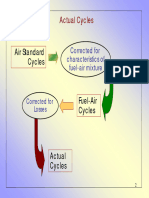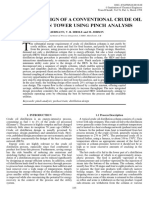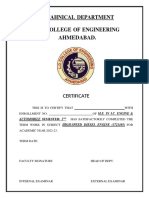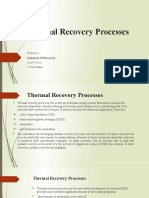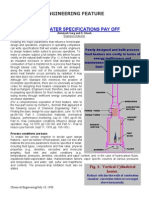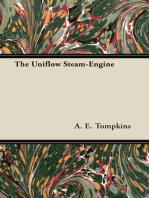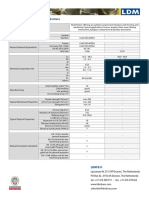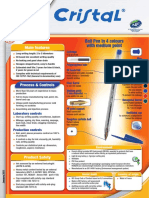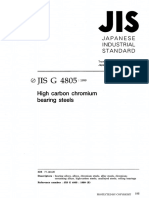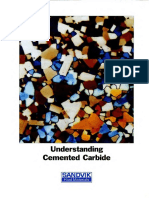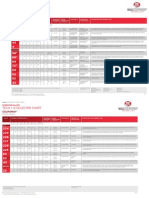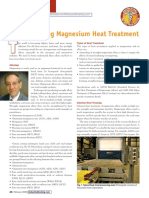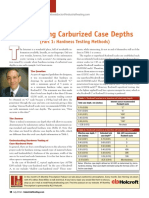Vacuum Oil Quenching: Applications and Unique Properties
Vacuum Oil Quenching: Applications and Unique Properties
Uploaded by
mp87_ingCopyright:
Available Formats
Vacuum Oil Quenching: Applications and Unique Properties
Vacuum Oil Quenching: Applications and Unique Properties
Uploaded by
mp87_ingCopyright
Available Formats
Share this document
Did you find this document useful?
Is this content inappropriate?
Copyright:
Available Formats
Vacuum Oil Quenching: Applications and Unique Properties
Vacuum Oil Quenching: Applications and Unique Properties
Uploaded by
mp87_ingCopyright:
Available Formats
HEAT TREATING
Vacuum Oil
Quenching:
Applications and
Unique Properties
Philippe Lebigot Tenova HTC Division: BMI Fours Industriels;
Saint Quentin Fallavier, FRANCE
Fig. 6. Example of a flexible vacuum
processing cell including oilquenching furnace
Hardening of steel is a major operation in heat treatment. Originally performed
in aqueous solution, the nature of the quenching media influences the final
steel characteristics and thus allows for optimization of the hardness, the
microstructure and also the deformation of the treated parts.
Quench Oil Problems
Like in any hardening process, the purpose of oil quenching is
to transform an austenitic phase into a martensitic structure by
imposing a rapid cooling in order to achieve the desired hardness
values.
Depending on the steel grades and cooling profiles, it is
possible to achieve several different structures (Fig. 1). When
the austenitized parts are plunged into the oil, several successive
cooling phases exist (Fig. 2).
Vapor phase: Oil in contact with the part will rise in
temperature by conduction and thus will produce moderate
cooling.
Boiling phase: Because of the heat effect, the oil transforms
into vapor phase. This will lead to fastest cooling due to
the absorption of the latent heat of vaporization. This is the
most decisive phase of the tempering/hardening operation
but also the most difficult to control. The formation of a
vapor sheath around the part can cause excessive insulation,
thereby reducing cooling-speed efficiency.
Convection phase: When the temperature becomes lower
and thus insufficient, the vapor phase disappears. The
convection of the oil can then finish the cooling to the
equilibrium temperature.
30
JANUARY 2016 IndustrialHeating.com
The adequacy of these theoretical curves ensures the success
of the operation. This vision is, of course, simplistic. Indeed, the
cooling of the part is never uniform because of different section
thicknesses of the part itself. These cooling heterogeneities
minor or important will lead to martensitic transformations at
different times during the quenching phase. The crossing of the
Ms point at a different time can generate abrupt part expansion
and cause distortions inherent in the quenching operation.
The increased cooling speed will lead to a higher temperature
Ac3
800
Ac1 700
Austenite + Ferrite
Austenite + Perlite
600
Temperature, C
epending on the steel grades and desired results, for
quenching the industry turned to either oil, salt bath or
(in recent years) pressurized inert gas with the growing
use of vacuum furnaces.
This paper will not detail the mechanisms of hardening. It
will, however, describe the potential of oil quenching performed
in a vacuum furnace in comparison to conventional oil
quenching and high-pressure gas quenching of 20 bar.
500
Ms
300
Mf
Ferrite + Perlite
Austenite + Bainite
400
Austenite + Martensite
200
100
A
1
B
10
103
102
Time, seconds
C
104
Fig. 1. Example of a CCT (continuous cooling transformation) diagram
of low-alloy steel. Microstructure depends on cooling speed. Area A
is predominantly a martensitic structure, typically the objective. B is
a mixed structure martensitic/bainitic, which is targeted if a higher
resilience (with resulting lower hardness) is desired. C has a structure
quite similar to equilibrium with hardening not being achieved.
Vapor
Boiling
Convection
800
Fusion
700
Solidification
Pressure
Temperature, C
600
500
400
300
Liquid
Critical
point
Solid
Evaporation
Solidification
Steam
200
100
0
Sublimation
0
8
10
12
Time, seconds
14
16
18
20
Fig. 2. Type of cooling-oil quenching profile. Various thermal-exchange
phases influence cooling speed.
gradient in the part. It is thus recommended to adjust the speed
to the optimum value.
Proper adjustment of quenching parameters allows
mechanical characteristics to be achieved, distortions to be
reduced and acceptable geometric criteria to be obtained. If the
gas quenching method reduces distortion by slowing the cooling
speed, it is not efficient for low-alloy steel and massive parts
because core hardness is difficult to achieve.
Condensation C
Triple point
Temperature
Fig. 3. Example of phase diagrams for a pure substance. Equivalent
diagrams are not available for quenching oils, which nevertheless follow
the same trends.
partial pressure of active gas allows the possibility of carburizing
or carbonitriding at low pressure and higher temperature, which
reduces cycle time.
Advantages During Heating
The heating takes place in a vacuum furnace, which allows
surface protection by the total absence of oxidation or
decarburization. The easy management of partial gas pressure
further expands the possibilities. Partial pressure of inert gas
(nitrogen, argon) limits alloying-element sublimation. Also,
Cooling Control
As the transfer of the charge is taking place under vacuum or
inert-gas protection after we vacuum purge the furnace, the part
surface is always protected until it is completely immersed into
the oil. Surface protection is very similar whether quenching in
oil or gas.
The major advantage compared to conventional atmospheric
oil-quenching solutions is the precise control of cooling
parameters. With a vacuum furnace, it is possible to modify the
standard quenching parameters temperature and agitation
and to also modify the pressure above the quenching tank.
Modifying the pressure above the tank will induce a
difference in pressure inside the oil bath, which changes the
oil-cooling efficiency curve defined at atmospheric pressure.
Indeed, the boiling zone is the phase during which the cooling
speed is the highest. The change in oil pressure will modify its
vaporization due to the heat of the load (Fig. 3).
Fig. 4. Example of a dense load of gears
Fig. 5. Example of a mixed load of gears of various mass
Advantages of Vacuum Oil Quenching
Vacuum heat treatment has become more common over the last
20 years. However, it is generally associated with pressurized
inert cooling gas. Vacuum oil quenching remains marginal, but
it presents interesting advantages for the industry.
IndustrialHeating.com JANUARY 2016
31
HEAT TREATING
The reduction of pressure will activate the vaporization
phenomena, which initiates the boiling phase. This will increase
the cooling efficiency of quenching fluid and improve hardening
capacity versus atmospheric condition. However, the massive
generation of steam can cause sheath phenomenon and incurs
potential deformation.
The increase of pressure in the oil inhibits the vapor
formation and retards evaporation. The sheath sticks to the
part and cools down more uniformly but less drastically. Oil
quenching in vacuum is therefore more uniform and incurs less
distortion.
The control of oil pressure combined with the choice of its
initial cooling specification, its temperature and its mode of
agitation gives the user additional leverage to optimize the
conditions for hardening, and it increases his capabilities to find
the right compromise between speed and homogeneity and,
therefore, between hardness and deformation.
Compared to a high-pressure gas quenching (HPGQ )
treatment usually used in vacuum or low-pressure furnaces,
the high cooling efficiency of oil offers a warranty and a safety
margin, especially with large-section parts or parts from lowhardenability steel. For these applications, the vacuum is no
longer an obstacle thanks to the quenching oil.
Experience shows that the accurate control of quenching
conditions, including the oil-pressure adjustment, can result
in deformation similar or better than can be achieved in gas
quenching with much higher charge densities (Fig. 4) and mixed
charges with fixtures and baskets (Fig. 5).
Low Costs of Maintenance and Consumables
The total absence of oxygen during quenching not only protects
the parts but also the oil from oxidation. The hardening
operation does not generate combustion of the oil as is the
case in conventional oil hardening, even under controlled
atmosphere.
As a result, oil aging is only limited to thermal cycling.
Convection
The characteristics of the oil, mainly its cooling efficiency and
viscosity, remain extremely stable over time, which improves
reproducibility of results and reduces needed controls.
Oil vapor produced during quenching is condensed on the
inner walls of the furnace, mainly in a water-cooled condenser
designed for this purpose. Thus, the oil returns directly to the
bath. Renewal is required only occasionally and partially, only to
complement consumption due to the retention by the parts when
they are unloaded.
The few impurities in the oil are generated from the load
only, so continuous filtering is not necessary. This eliminates the
risk of clogging and consumption of oil filters.
The consumption of neutral gas is also limited to the needs
of filling the quenching tank at a pressure close to atmospheric.
Compared with the best solutions for high-pressure gas
quenching and equivalent load, this consumption is reduced by
a factor of 10-15. The use of expensive gases or mixtures is no
longer necessary to ensure the quenching quality.
Ease of Industrial and Environmental Integration
Vacuum furnaces have proven their integration ease into
industrial units. This is even more evident in the case of a
vacuum oil-quenching furnace. For example:
The use of cold walls and the lack of flames or burners
ensures complete safety for operators.
The containment of vapors in a sealed enclosure and the
extraction of the heat-treatment residuals from vacuum
pumps protect the workshop from heat-treatment exhaust.
This allows integration into a flexible cell (Fig. 6-intro) or
even the tool shop.
The low inertia of the heating chamber, designed on the
same principle as the gas-cooled vacuum furnace, allows
furnace shutdown when it is not used. Significant energy
savings can be made during nonworking days without
affecting the productivity of the equipment during the
restart.
Internal door
Mechanical lifter
Sliding door
Fig. 7. Oil vacuum furnace type P164TH
32
JANUARY 2016 IndustrialHeating.com
Fig. 8. Functioning principle of P16_TH series
Oil-Quenching Vacuum Furnace Technology
Principle
The technology of vacuum oil quenching is very close to vacuum
gas-cooled furnaces.
All or part of the external enclosure is cooled by doublewall water circulation.
Building materials and insulation of the heating chamber
are mainly derived from graphite. A convection turbine may
be available to improve the circulation at low temperature
<750C.
Groups of pumps allow evacuation of the enclosure.
Oil quenching adds subassembly to complete the equipment.
A specific example can be seen in Figures 7 and 8. The
subassembly includes:
An oil tank, equipped with propellers, heating elements and
cooling exchanger
A load-handling system allows automatic and fast transfers
between the area of loading/unloading, the heating
chamber and the quenching tank.
Elements for Furnace-Type Selection
The range of oil-quenching vacuum furnaces has expanded in
recent years. Many solutions are now available, and the user
must do a precise analysis to select the most adequate equipment
to serve production. The following factors must be analyzed.
Volume and gross load: These are the first elements to be
defined. They are based on unit size and shape of the most
cumbersome parts and production volume. Depending on
the furnace technology (one- or two-chamber), the cycle
time can vary, which impacts the size of the furnace.
Vacuum level required: If a primary vacuum level is usually
sufficient for hardening low-alloy steels, some more exotic
applications may require a higher vacuum. The twochamber furnaces allow the addition of a diffusion pump.
Flexibility of cooling: Oil quenching can be complemented
with accelerated cooling by forced convection of inert gas.
This allows performing the carburizing and annealing
operations, for example. Oil/gas quenching can be equipped
with a high-pressure cooling chamber and thus expand the
range of steels, which increases the equipment versatility.
Need for load thermocouple(s): Some applications (e.g.,
aerospace industry) may require the use of these pyrometers.
The complexity of the systems implemented and the
short life of oil-cooled thermocouples limit their use to a
minimum.
Transfer time: Alloys with low hardenability require quick
transfer time. If the 20-40 seconds of transfer time can be
achieved in almost all modern ovens, a need for transfer
time of less than 15-20 seconds limits the number of
equipment options in the market.
Possibility of civil engineering: Some installations require
a pit to be installed, and some do not. In some cases (e.g.,
flexible cells), solutions such as mezzanine can replace the
pit configurations, provided that the height of the building
is compatible.
Range of Vacuum Furnaces with Tempering Oil
If you are in search of a vacuum furnace with quench oil, a range
of products exist. Each of these products has its advantages and
limitations. These include horizontal furnaces with single or
double chambers for oil and gas quenching. Some designs handle
larger volumes, and some are better for a shop with smaller
loads. Multiple-chamber vertical furnaces are also available.
These are good for distortion control on long parts but typically
require a pit and a larger initial investment. Identify your specific
requirements before purchasing your vacuum furnace.
Conclusion
Vacuum oil quenching is a less-familiar process. Combining
the benefits of vacuum safety with the quality of treatment,
however, provides an industrial solution that is efficient, clean
and competitive.
These advantages face a number of wrong assumptions,
including:
The pieces soaked in oil are distorted. An adequate adjustment and a precise control of the hardening conditions can
often do better in terms of deformation than HPGQ.
The pieces soaked in oil should be cleaned. It is true that
cleaning after quenching is necessary to remove the oil.
However, the oil film on the surface preserves the part to
the point that it is impossible to make the visual difference
between a part soaked with oil or gas. In addition,
generally, a washing solution is already required before heat
treatment. The additional step of cleaning often does not
require more equipment or significant additional costs.
Vacuum oil-quenching furnaces are expensive. Like any piece
of equipment, the competitiveness of a furnace must be an
assessment of its investment cost and operation. Providing
benefits including reduced cost of consumables, this solution
may be more competitive in the medium term. In addition,
the cost of single-chamber oil vacuum furnaces is particularly
attractive, even compared to traditional furnaces.
The option of vacuum oil quenching must be carefully
analyzed by any company planning to invest in equipment
for heat treatment of low-alloy steels. It must be compared
with conventional oil-quenching solutions and the HPGQ
alternative, integrating operating costs and enhancing the
potential productivity gains offered by this technology.
For more information: Contact Laurent Charra, Tenova HTC Division BMI Fours Industriels, 65 Rue du Ruisseau 38897 Saint Quentin
Fallavier, France; e-mail: laurent.charra@tenova.com; website:
www.bmi-fours.com
IndustrialHeating.com JANUARY 2016
33
You might also like
- Vacuum Hardening HssDocument6 pagesVacuum Hardening Hssharanus2000No ratings yet
- Omv enDocument50 pagesOmv enMuhamad Saukie100% (1)
- Igtc2003tokyo ts098Document7 pagesIgtc2003tokyo ts0981hass1No ratings yet
- C CC CC: CCCCCCCCCCCCCCCCDocument27 pagesC CC CC: CCCCCCCCCCCCCCCCMuhammadTanzeeLUsmanNo ratings yet
- Simulation of A Visbreaking UnitDocument5 pagesSimulation of A Visbreaking UnitPablo PaganiNo ratings yet
- 2007 Rev Revamping AtmosphericDocument3 pages2007 Rev Revamping Atmosphericsyamsudin2006No ratings yet
- Vacuum Heat Treatment of FastenersDocument6 pagesVacuum Heat Treatment of Fastenersshunmu_scribNo ratings yet
- An Atmospheric Crude Tower RevampDocument6 pagesAn Atmospheric Crude Tower RevampMarlon Arteaga100% (1)
- Vis BreakingDocument21 pagesVis BreakingAhmed Hassan RashedNo ratings yet
- Wear Procces DieselsDocument6 pagesWear Procces Dieselsargentum19619692No ratings yet
- Qip-Ice-09-Actual Cycles PDFDocument28 pagesQip-Ice-09-Actual Cycles PDFankit ghildiyalNo ratings yet
- Houghton On QuenchingDocument76 pagesHoughton On QuenchingHigginsDitchNo ratings yet
- 3 Gas and Oil FuelsDocument20 pages3 Gas and Oil FuelsCristhian Garcia VillarroelNo ratings yet
- 9 Actual CyclesDocument27 pages9 Actual Cyclesxemovi7309No ratings yet
- 3 CDU W Pinch Analysis LiebmannDocument13 pages3 CDU W Pinch Analysis LiebmannAnsinath Barathi100% (1)
- Economizers: Colin FrenchDocument6 pagesEconomizers: Colin Frenchsathesh100% (1)
- Design Combustion ReactorDocument8 pagesDesign Combustion ReactorTibi OprutaNo ratings yet
- Design and Operating - Fouling CDU HeatersDocument8 pagesDesign and Operating - Fouling CDU HeatersFranklin Santiago Suclla Podesta100% (2)
- 2020 Technology and Operation of A Hot Rolling MilDocument8 pages2020 Technology and Operation of A Hot Rolling MilHakanNo ratings yet
- Fallsem2016-17 2134 RM001 09-Aug-2016 Che2006 THDocument35 pagesFallsem2016-17 2134 RM001 09-Aug-2016 Che2006 THsinsnigNo ratings yet
- Temperature Pressure Ls Diesel EnginesDocument8 pagesTemperature Pressure Ls Diesel EnginesCvita CvitićNo ratings yet
- Blast Furnace Bosh Design and RepairsDocument16 pagesBlast Furnace Bosh Design and RepairsAnindya RoyNo ratings yet
- Burners: Air-Steam Atomizing Oil BurnersDocument8 pagesBurners: Air-Steam Atomizing Oil BurnersAhmed GadNo ratings yet
- Boiler BurnerDocument12 pagesBoiler BurnerSumeet SawantNo ratings yet
- Boiler Heat Transfer Theory-02Document18 pagesBoiler Heat Transfer Theory-02Sai SwaroopNo ratings yet
- Bwts Library 105 327Document12 pagesBwts Library 105 327joão_scherer_1No ratings yet
- Quench Press ProcessDocument6 pagesQuench Press ProcessLORENZO GOMEZNo ratings yet
- Heater TubesDocument8 pagesHeater TubesJay Lawson0% (1)
- Refinery BasicsDocument31 pagesRefinery Basicsanurag100% (1)
- Temperature Pressure Ls Diesel Engines PDFDocument8 pagesTemperature Pressure Ls Diesel Engines PDFПетрNo ratings yet
- Cast Heater White PaperDocument3 pagesCast Heater White Paperssmith2007No ratings yet
- Siemens Gas Turbine SGT 500 Crude OilDocument10 pagesSiemens Gas Turbine SGT 500 Crude Oilgeverett2765No ratings yet
- CDU DesignDocument8 pagesCDU DesignAnonymous DcE7fcjSwNo ratings yet
- The Herring Group, Inc.: Professional Support ServicesDocument24 pagesThe Herring Group, Inc.: Professional Support ServicesskluxNo ratings yet
- Petroleum Technology-Part Iii: The Process & Technology of CrackingDocument23 pagesPetroleum Technology-Part Iii: The Process & Technology of CrackingSrikrishnan KrishNo ratings yet
- Aph 15Document0 pagesAph 15Parameswararao BillaNo ratings yet
- Low Press Carbg and High Press QNCHGDocument56 pagesLow Press Carbg and High Press QNCHGskluxNo ratings yet
- Soot Deposits and Fires in Exhaust Gas BoilersDocument21 pagesSoot Deposits and Fires in Exhaust Gas BoilersJose G. CastilloNo ratings yet
- Fuel Savings For Slab Reheating Furnaces Through Oxyfuel CombustionDocument6 pagesFuel Savings For Slab Reheating Furnaces Through Oxyfuel CombustionДимитър СлавовNo ratings yet
- ABB Turbocharging - Operating Turbochargers PDFDocument35 pagesABB Turbocharging - Operating Turbochargers PDFrajishrrrNo ratings yet
- HSD Term 22-23 EvenDocument38 pagesHSD Term 22-23 EvenViraj ParmarNo ratings yet
- Steam Generator PerformanceDocument7 pagesSteam Generator Performancervkumar61No ratings yet
- Faculty of Geology and Petroleum Engineering 2Document11 pagesFaculty of Geology and Petroleum Engineering 2Алишер ДжумагуловNo ratings yet
- Boil-Off Gas Handling Onboard LNG Fuelled ShipsDocument6 pagesBoil-Off Gas Handling Onboard LNG Fuelled ShipsPutu Indra Mahatrisna100% (1)
- Thermal Recovery Processes: ReferenceDocument10 pagesThermal Recovery Processes: Referenceحسين رامي كريم A 12No ratings yet
- Lecture 8 Conversion Processes-1Document27 pagesLecture 8 Conversion Processes-1Youssif SalamaNo ratings yet
- Overiew of Comb Cycle Rev 7.0 - Part 1Document161 pagesOveriew of Comb Cycle Rev 7.0 - Part 1Balajirao SamathamNo ratings yet
- Soot Deposits and Fires in Exhaust Gas Boilers: MAN DieselDocument28 pagesSoot Deposits and Fires in Exhaust Gas Boilers: MAN Dieselvran77No ratings yet
- Cooling of IC EnginesDocument11 pagesCooling of IC EnginesVARUN VARMA JAGANATHNo ratings yet
- Economizer, Furnace, Burner, Air Fuel RatioDocument11 pagesEconomizer, Furnace, Burner, Air Fuel RatioPriyaNo ratings yet
- Assignment: Cogeneration and Waste Heat Recovery SystemsDocument8 pagesAssignment: Cogeneration and Waste Heat Recovery Systemsd_raj187No ratings yet
- Thermal Barrier Coating For Gas Turbine EngineDocument10 pagesThermal Barrier Coating For Gas Turbine EngineArif KhanNo ratings yet
- Good Heater Specifications Pay OffDocument6 pagesGood Heater Specifications Pay Offrvkumar61100% (2)
- Gas-Engines and Producer-Gas Plants A Practice Treatise Setting Forth the Principles of Gas-Engines and Producer Design, the Selection and Installation of an Engine, Conditions of Perfect Operation, Producer-Gas Engines and Their Possibilities, the Care of Gas-Engines and Producer-Gas Plants, with a Chapter on Volatile Hydrocarbon and Oil EnginesFrom EverandGas-Engines and Producer-Gas Plants A Practice Treatise Setting Forth the Principles of Gas-Engines and Producer Design, the Selection and Installation of an Engine, Conditions of Perfect Operation, Producer-Gas Engines and Their Possibilities, the Care of Gas-Engines and Producer-Gas Plants, with a Chapter on Volatile Hydrocarbon and Oil EnginesNo ratings yet
- Marvel Carbureter and Heat Control: As Used on Series 691 Nash Sixes Booklet SFrom EverandMarvel Carbureter and Heat Control: As Used on Series 691 Nash Sixes Booklet SNo ratings yet
- Process Steam Systems: A Practical Guide for Operators, Maintainers, and DesignersFrom EverandProcess Steam Systems: A Practical Guide for Operators, Maintainers, and DesignersNo ratings yet
- The Art of Lead Burning: A practical treatise explaining the apparatus and processesFrom EverandThe Art of Lead Burning: A practical treatise explaining the apparatus and processesNo ratings yet
- Leaded Nickel SilverDocument1 pageLeaded Nickel Silvermp87_ingNo ratings yet
- Cox MerzDocument4 pagesCox MerzJohnNo ratings yet
- LDM CuNi7Zn39Pb3Mn2 MSDSDocument4 pagesLDM CuNi7Zn39Pb3Mn2 MSDSmp87_ingNo ratings yet
- Using The Power Law Model To Quantify Shear Thinning Behavior On A Rotational RheometerDocument7 pagesUsing The Power Law Model To Quantify Shear Thinning Behavior On A Rotational Rheometermp87_ingNo ratings yet
- Ball Pen in 4 Colours With Medium Point: Main FeaturesDocument1 pageBall Pen in 4 Colours With Medium Point: Main Featuresmp87_ingNo ratings yet
- CDA Benzotriazole Corrosion Inhibitor For Copper Alloys PDFDocument10 pagesCDA Benzotriazole Corrosion Inhibitor For Copper Alloys PDFmp87_ingNo ratings yet
- Fatigue, Static Tensile Strength and Stress Corrosion of Aircraft Materials and StructuresDocument232 pagesFatigue, Static Tensile Strength and Stress Corrosion of Aircraft Materials and Structuresmp87_ing100% (1)
- JIS G4805:1999 High Carbon Chromium Bearing SteelsDocument34 pagesJIS G4805:1999 High Carbon Chromium Bearing Steelsmp87_ingNo ratings yet
- SANDVIK Understanding Cemented Carbide PDFDocument20 pagesSANDVIK Understanding Cemented Carbide PDFmp87_ingNo ratings yet
- Alloy CarbidesDocument2 pagesAlloy Carbidesmp87_ing100% (1)
- Wall Colmonoy Surfacing Alloys Selector ChartDocument3 pagesWall Colmonoy Surfacing Alloys Selector Chartmp87_ingNo ratings yet
- Strategies For Eliminating DecarburizationDocument3 pagesStrategies For Eliminating Decarburizationmp87_ingNo ratings yet
- Understanding Magnesium Heat TreatmentDocument2 pagesUnderstanding Magnesium Heat Treatmentmp87_ingNo ratings yet
- A Chrome Alternative For Corrosive EnvironmentsDocument3 pagesA Chrome Alternative For Corrosive Environmentsmp87_ingNo ratings yet
- Interpreting Carburized Case DepthsDocument4 pagesInterpreting Carburized Case Depthsmp87_ing100% (1)
- Revealing Prior-Austenite Grain Boundaries in Heat-Treated SteelsDocument5 pagesRevealing Prior-Austenite Grain Boundaries in Heat-Treated Steelsmp87_ingNo ratings yet
- Portfolios Assessment: Prepared By: Dolgor G. Anujin D. Khongorzul M. Narangerel KHDocument20 pagesPortfolios Assessment: Prepared By: Dolgor G. Anujin D. Khongorzul M. Narangerel KHНаран ГэрэлNo ratings yet
- Chopra Book ReviewDocument3 pagesChopra Book ReviewShawkat Tanveer RahmanNo ratings yet
- Updates Dec09 AIAG FMEA-Ranking-TablesDocument3 pagesUpdates Dec09 AIAG FMEA-Ranking-TablesSuresh Velu100% (1)
- New Microsoft Word Document BBBDocument139 pagesNew Microsoft Word Document BBBrhinonanaNo ratings yet
- United States v. Harold Joseph Rosenthal, Philip Anthony Bonadonna, Robert Edward Dunleavy, Jr., George Lombardi, Garland Hubert Watson, Larry Roger Stewart, Joseph Vincent Junker, United States of America v. Rose Marie Junker, United States of America v. Dennis Wayne Wilson, 801 F.2d 378, 11th Cir. (1986)Document3 pagesUnited States v. Harold Joseph Rosenthal, Philip Anthony Bonadonna, Robert Edward Dunleavy, Jr., George Lombardi, Garland Hubert Watson, Larry Roger Stewart, Joseph Vincent Junker, United States of America v. Rose Marie Junker, United States of America v. Dennis Wayne Wilson, 801 F.2d 378, 11th Cir. (1986)Scribd Government DocsNo ratings yet
- Double OB With BOS Bounce: Smart Money Concept - SMCDocument8 pagesDouble OB With BOS Bounce: Smart Money Concept - SMCPlay PositionNo ratings yet
- Food Eating Habits Vocabulary Quiz - 40566Document2 pagesFood Eating Habits Vocabulary Quiz - 40566lanaNo ratings yet
- Operating and Maintenance Manual: Model "SRN and HRN" Atmospheric Steam BoilerDocument116 pagesOperating and Maintenance Manual: Model "SRN and HRN" Atmospheric Steam BoilerAntonio MoralesNo ratings yet
- Custom - AspxDocument11 pagesCustom - Aspxelvi036246No ratings yet
- Columbia County Property Transfers 5-2 To 5-8Document1 pageColumbia County Property Transfers 5-2 To 5-8augustapressNo ratings yet
- Scope Resolution Via LEGB RuleDocument8 pagesScope Resolution Via LEGB RuleArpanaNo ratings yet
- An Automatic Egg Collection Systerm - June 2022 EdittedDocument38 pagesAn Automatic Egg Collection Systerm - June 2022 EdittedWamema joshuaNo ratings yet
- Introduction To Migration To New General LedgerDocument18 pagesIntroduction To Migration To New General LedgerGurpreet Singh100% (1)
- Acp-2010 2320 DS (041123) 20230412143317Document2 pagesAcp-2010 2320 DS (041123) 20230412143317Quân BùiNo ratings yet
- Isaac Kwanin BoachieDocument4 pagesIsaac Kwanin BoachieIbrahimNo ratings yet
- Rule 48 Precautions Against Leakage Before ConnectionDocument23 pagesRule 48 Precautions Against Leakage Before ConnectionRK KNo ratings yet
- Danimal in South Africa-Management Innovation at The Bottom of The PyramidDocument15 pagesDanimal in South Africa-Management Innovation at The Bottom of The PyramidANANDYITA SINHANo ratings yet
- Pavement Design Manual: Arizona Department of TransportationDocument71 pagesPavement Design Manual: Arizona Department of TransportationGeorge ClooneyNo ratings yet
- 1.sonokinetic Carousel 2020 Product ManualDocument13 pages1.sonokinetic Carousel 2020 Product ManualVictor HugoNo ratings yet
- Class 10 Computer Application Code 165 Study MaterialDocument2 pagesClass 10 Computer Application Code 165 Study Material71989100% (3)
- Chapter IV PLANING CRAFT - Daniel SavitskyDocument29 pagesChapter IV PLANING CRAFT - Daniel Savitskyldigas100% (1)
- 2020 IJDRBE - Modular School DesignDocument13 pages2020 IJDRBE - Modular School DesignWidya PNo ratings yet
- Caudle StatementDocument9 pagesCaudle StatementThereseApelNo ratings yet
- BUSINESS PLAN-mabek Hair StudioDocument6 pagesBUSINESS PLAN-mabek Hair StudioBright IdemudiaNo ratings yet
- Supreme Court: Domingo E. de Lara & Associates For Petitioner. Manual A. Alvero & Associates For Private RespondentDocument37 pagesSupreme Court: Domingo E. de Lara & Associates For Petitioner. Manual A. Alvero & Associates For Private RespondentMaria Zola Estela GeyrozagaNo ratings yet
- Alohomora Unlocking Data Quality Causes Through Event Log ContexDocument16 pagesAlohomora Unlocking Data Quality Causes Through Event Log Contexsanaz.mohammadzade13No ratings yet
- Matecconf Sacam21 00024Document12 pagesMatecconf Sacam21 00024mariamalloney1730No ratings yet
- T-Bar Product InformationDocument14 pagesT-Bar Product InformationEd2sverissimoNo ratings yet
- 2.advanced Compiler Support For ILPDocument16 pages2.advanced Compiler Support For ILPThyaga Rajan100% (1)
- Foundation-1.5 SA & DADocument1 pageFoundation-1.5 SA & DADhilipkumar GNo ratings yet
